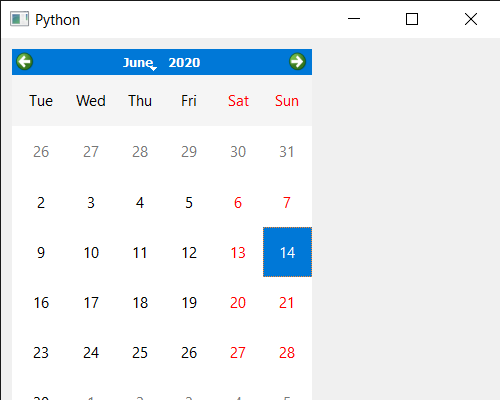En este artículo veremos cómo podemos establecer el ancho fijo en el QCalendarWidget. El ancho fijo del calendario es ese ancho, que no se puede encoger ni estirar más, por defecto, cuando creamos un calendario dentro del diseño y cuando la ventana se extiende o se encoge, el tamaño del calendario también aumenta y se encoge, por lo tanto, hay necesita establecer el ancho fijo.
Para hacer esto, usaremos
setFixedWidthel método con el objeto QCalendarWidget.Sintaxis: calendar.setFixedWidth(300)
Argumento: Toma entero como argumento
Retorno: No devuelve Ninguno
A continuación se muestra la implementación.
# importing libraries
from PyQt5.QtWidgets import *
from PyQt5 import QtCore, QtGui
from PyQt5.QtGui import *
from PyQt5.QtCore import *
import sys
# QCalendarWidget Class
class Calendar(QCalendarWidget):
# constructor
def __init__(self, parent = None):
super(Calendar, self).__init__(parent)
self.setMouseTracking(True)
class Window(QMainWindow):
def __init__(self):
super().__init__()
# setting title
self.setWindowTitle("Python ")
# setting geometry
self.setGeometry(100, 100, 500, 400)
# calling method
self.UiComponents()
# showing all the widgets
self.show()
# method for components
def UiComponents(self):
# creating a layout
layout = QVBoxLayout()
# creating a QCalendarWidget object
# as Calendar class inherits QCalendarWidget
self.calendar = Calendar(self)
# setting cursor
self.calendar.setCursor(Qt.PointingHandCursor)
# adding calendar tot he layout
layout.addWidget(self.calendar)
# setting fixed width
self.calendar.setFixedWidth(300)
# setting layout
widget = QWidget()
widget.setLayout(layout)
self.setCentralWidget(widget)
# create pyqt5 app
App = QApplication(sys.argv)
# create the instance of our Window
window = Window()
# start the app
sys.exit(App.exec())
Producción :
Publicación traducida automáticamente
Artículo escrito por rakshitarora y traducido por Barcelona Geeks. The original can be accessed here. Licence: CCBY-SA